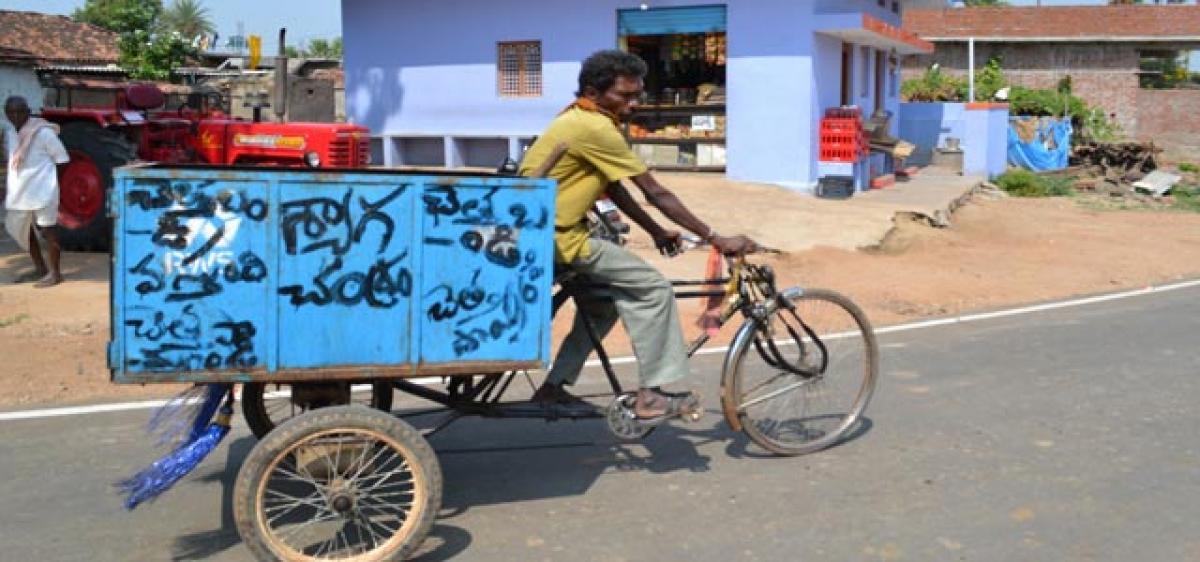Live
- Supreme Court issues notice on PIL seeking directions to integrate legal education, self-defence training into school curriculum
- Bengal school jobs case: Arpita Mukherjee granted bail; new HC Bench to look into Partha Chatterjee's plea
- Working to provide social security for gig and platform workers: Govt
- Bangladesh records 11 dengue deaths, toll rises to 459
- Vocera Raises $500K from Y Combinator to Revolutionize Voice AI Testing and Evaluation
- GQG Partners Refuses to Sell Adani Stocks Despite Bribery Scandal and 26% Loss
- Bihar: Four persons including girl injured in post bypolls violence in Gaya
- Dharmasthala Dharmadhikari Enters Record Book
- BJP to Review By-election Losses in State Meet
- Activist Alleges CPCB Cover-up on Endosulfan in Kasaragod
Just In

It was during the ordeal of drought in this region without respite almost 20 years ago, Naxalism thrived in Ibrahimpur and its neighbouring villages.
Siddipet: It was during the ordeal of drought in this region without respite almost 20 years ago, Naxalism thrived in Ibrahimpur and its neighbouring villages. Three Naxals belonging to the CPI (ML) Peoples War Group were gunned down in the neighbouring village. Among those who were killed in the encounter was Madhu, a native of Ibrahimpur. Today a Martyrs Memorial which was built in memory of them still stands there, of course in a pitiful condition.
Ibrahimpur has gone a long way from being a Naxal bastion to transforming into a model village for sustainable development. It all started with a genuine endeavour by the villagers to transform their village as a model village. From becoming outside defecation-free to implementing clean and green initiatives and continuing with their collective spirit, the villagers have now attained such a high point where not only Telangana State, but entire India is taking inspiration from Ibrahimpur today.
The village was declared the first village to go cashless in South India and the second in the country to do so, the story of development in Ibrahimpur only keeps getting better. Just before the start of kharif season, the villagers had taken a decision to dig boundary trenches around the periphery of their agricultural lands as a way to harvest rain water and increase the ground water levels. The effort bore fruit in September, when rains filled every irrigation tank and well to the brim.
Much before this, the villagers had completed digging soak-pits in every house, making great use of NREGS and Swachh Bharat funds. The village has been implementing solid waste management ever since a dump yard was constructed in the village. Hardly any piece of paper could be found on the streets of the village and due to construction of soak-pits, stagnation of water in the village ended, driving away mosquitoes and hence reducing healthcare costs in the village considerably.
The villagers have transformed waste land into a village park and have left no open space without planting trees. In this year’s Haritha Haram programme, the villagers planted 1.5 lakh saplings on a single day and keep continuing to do so every day. With Nirmal Bharat Puraskar in 2013, Best Gram Panchayat Award in 2015 and appreciation from Governor E S L Narasimhan who took part in the mass plantation programme in the village, State government has granted funds to the village for any developmental initiative undertaken by the villagers.
“It was certainly a great collective effort of the villagers, but it would not have been possible without continuous encouragement, moral and financial support from Minister for Irrigation T Harish Rao who adopted our village,” said Kumbala Laxmi, the village sarpanch while speaking with The Hans India.
However, with power and fame also come arrogance and a feeling of impunity. In January, the murder of Srihari (30), a beedi munim (a person who supplies raw materials to beedi workers) allegedly by the sarpanch’s sons and their friends had triggered mob frenzy which went to the point where people from neighbouring villagers torched Laxmi’s house and even tried to kill her. Police rescued the sarpanch’s family and as per sources, the issue has reached a compromise between the parties involved.
Across the street from the sarpanch’s burnt house lies the martyrs memorial which is now in a shambles. The bricks and cement of the memorial have started crumbling down and the red colour has faded away. The youth have no idea why the memorial was erected back in 1997 and do not even know about Madhu or his fellow comrades Kanakayya and Mallesh, who were also killed in that encounter.
All they care about now is about how to keep up their good collective work and to looks for ways to introduce new things in their village, creating employment locally for unemployed youth in the village. Internal war between different factions of radicals, combined with an improved communication system and loss of credibility on Marxist-Leninist groups among the villagers during the late 90s had triggered large-scale encounters and virtual elimination of Naxals from the villages.
People who laid foundations for people’s movements had already been eliminated in a conflict between various factions of Naxals and the police. Those Naxals who survived left the State to join Maoist Party after the merger of PWG and Central Maoist Party.
By Vivek Bhoomi

© 2024 Hyderabad Media House Limited/The Hans India. All rights reserved. Powered by hocalwire.com







